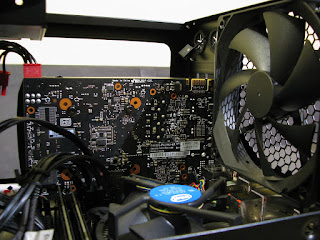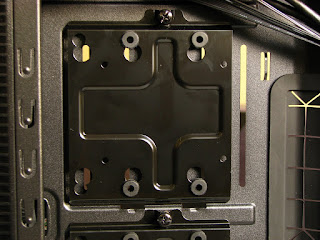Today I'll try to share something with you about another case I had in my hands lately. As the title says - it was an Antec ISK 600M. It's a micro-ATX Cube case, measuring 290mm (H) x 272,6mm (W) x 340mm (D), comes in stylish black colour.
Exteriors
Antec decided to play safe when it comes to the front panel. It's made of plastic imitating brushed aluminum, and a mat bezel with front interface on it. There's also a place for slim optical drive.
 |
| ISK 600M front panel |
The front interface is quite conventional. On the left side of it you will find one USB 3.0 port, audio and mic jacks and one USB 2.0 port. The blue USB 3.0 can be also connected as USB 2.0, as the cable has two type of connectors and attached instrucions saying to use only one of them. Sadly, USB 2.0 is on a separate cable, which means that with some motherboards (especially smaller ones) you won't be able to connect both of those USB front ports.
 |
| Left side of the front interface |
Right side of the front interface is composed of Reset and Power buttons, hidden underneath pieces of flexible plastic, which has to be pushed in to use those switches. This construction prevents the user from pushing them accidentally, but I’m not sure about durability of those plastic plates.
 |
| Right side of the front interface |
A blue LED strip is hidden underneath the front panel bottom side, making surface under the case light up with aural effect. You will have to connect it to an external power though, using a molex plug.
On the left side of the case you will find air vents for the front 140mm fan. Additionally you can observe the height the case stands from the surface and it’s standard feet. There’s also a cutout that allows a GPU better airflow.
 |
| Left side of the case |
The right side of the case is very similar, but the airflow cutout is longer. Both panels and the top of the case are actually a one sheet of steel.
 |
| Right side of the case |
On the back you can find pretty standard cutouts, although they tell you a bit about how the interiors of Antec ISK 600M are arranged. First of all, motherboard will be mounted horizontally, GPU and other expansion cards vertically. There’s room for a full ATX power supply on the floor, protected with dust filter made of fine mesh strapped on a plastic frame.
 |
| Back side of the case |
There’s also some rubber grommets for custom liquid cooling solutions, additional air vents and one 120mm exhaust fan. As you can see, there are four back slot covers that can be reattached, that are hold in place with additional metal frame. It’s quite good system, allowing you to easily remove or put those covers back in place.
 |
| Back side of the case |
Bottom side won’t surprise you too – there’s a dust filter for the PSU, some mounting cutouts and LED strip in the front. As you can see, front feet are removable, back ones are glued on.
 |
| Bottom side of the case |
Interiors
When you take the sheet of steel covering both sides and the top of this case, you will see two chambers of the Antec ISK 600M. Bottom one, a smaller one, will hold your PSU and up to three 3,5” drives in a bay. There’s a place for additional 80mm fan that will take the hot air from those drives and exhaust it on the back. There’s a lot of space for cables here, and you will be able to connect those drives easily. The PSU sits on a dampening foam strips.
 |
| Bottom chamber |
In the main chamber you will mount rest of your components. The case is compatible with Micro-ATX and Mini-ITX standard motherboards. You will be able to put a GPU as long as 312mm and a CPU cooler up to 175mm height. The top side of the case holds a bracket for up to four 2,5” drives and a slim optical drive.
 |
| Interiors |
Left side of the interior has mounting holes for two additional 120mm fans, but mounting both of them means you won’t be able to use that top drives bracket. The front panel is easily detachable with plastic latches on both sides. The front fan is protected with loosely grilled metal plate of the front side, but there are some cutouts and space to run some of your cables to the top drive bracket.
 |
| Removed front panel |
Both case fans have manual RPM controllers. I was able to put the exhaust fan controller outside of the case using those rubber grommets, but there is no way to get access to the front one from the outside of the case, which is a bummer.
 |
| Więcej wnętrza |
Summary
Antec ISK 600M is a very interesting, mid-range case offering nice form-factor and a lot of space inside to mount some more powerful hardware. As far as main cons of this case come, it might be impossible to use both of those front USB ports at the same times with many smaller motherboards. The mounting system for additional side fans could be done smarter to allow use of the top drive bracket. Also, the front fan could be placed better. There are a lot of space under that front cover, but that fan is exactly on the same width as those air vents, and that won’t give you great airflow in there. Those fan RPM controllers are a bit weird too, it’d be better to include a simple fan controller on the front side of the case and connect both those fan to that.
As for the pros, the build quality is really great for this price point – it’s very stable, doesn’t wobble and still quite light. Expanding options are great too. You can mount six fans overall in this case! I think that you could put a CPU AiO cooler in there, not only with 120mm rad, but a 240. slim one too. There’s also enough space in both compartments to run a custom loop in there, especially if you go with the smallest motherboards. It could use some more cable management tie points, because I found only two of those, and they weren’t very useful with the small board I used for this build.
Personally, I would give Antec ISK 600M a solid 4+/5 score, especially thanks to the price of this case. It’s definitely a very nice case for someone who wants to go for smaller form factor, but still would like to have a lot of space for larger components and a lot of space to work with. Good job, Antec! :)











































